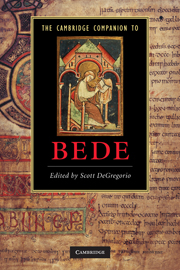Book contents
- Frontmatter
- Part I Bede’s Life and Context
- 1 Bede’s life in context
- 2 Secular and political contexts
- 3 The world of Latin learning
- 4 Church and monastery in Bede’s Northumbria
- 5 British and Irish contexts
- 6 The foundation of Bede’s Wearmouth-Jarrow
- Part II Bede's Writings
- Part III Reception and Influence
- Further reading
- Bibliography
- Index
5 - British and Irish contexts
from Part I - Bede’s Life and Context
Published online by Cambridge University Press: 28 January 2011
- Frontmatter
- Part I Bede’s Life and Context
- 1 Bede’s life in context
- 2 Secular and political contexts
- 3 The world of Latin learning
- 4 Church and monastery in Bede’s Northumbria
- 5 British and Irish contexts
- 6 The foundation of Bede’s Wearmouth-Jarrow
- Part II Bede's Writings
- Part III Reception and Influence
- Further reading
- Bibliography
- Index
Summary
Near the beginning of his Ecclesiastical History of the English People, Bede notes the use of five languages in Britain: English, British, Irish, Pictish and Latin (I. 1). Latin was the language of the Church. For the rest, Bede's wording skilfully circumvents the problem that political frontiers did not necessarily march with linguistic frontiers. Broadly speaking, Bede presented Britain as inhabited by four major peoples: north of the Forth, on the east side of what is now Scotland, were the Picts. To their west were the Irish of the kingdom of Dál Riada, relatively recent colonists from Ireland. (We may note here that Bede's term for the Irish, Scotti, does not distinguish between those living in Ireland and those in western Scotland.) South of the Forth-Clyde isthmus was the land of the Britons, the original inhabitants of Britain. But after the Romans had withdrawn their soldiers, the Britons had invited in the 'English or Saxons' from across the North Sea to help defend their land (I. 15). Settled in the east of Britain, these had soon seized control of land from the Britons. This trend continued, so that in the period covered by Bede's history the area under British control contracted towards the west, ultimately leaving them with just rump kingdoms: Dumnonia in the southwest, shrinking westwards to become Cornwall; Gwynedd, Powys and other kingdoms in what came to be Wales; and Strathclyde in what is now southwest Scotland.
- Type
- Chapter
- Information
- The Cambridge Companion to Bede , pp. 69 - 83Publisher: Cambridge University PressPrint publication year: 2010
- 2
- Cited by



